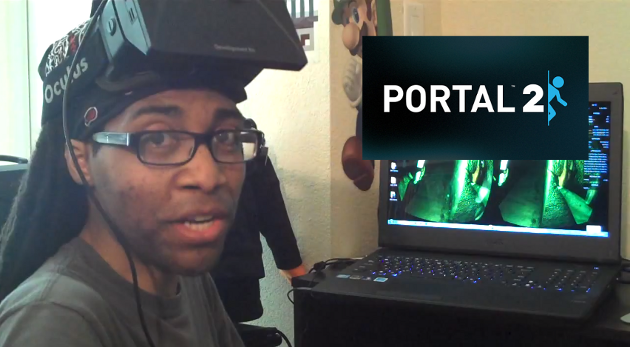Greetings Road To VR Readership!
In partnership with Road To VR, I present Cymatic Bruce’s Video Breakdowns! For those that do not know me, I am a VR Vlogger that has been producing Oculus Rift gameplay videos and VR Development observations. You can check out what I have been up to on my YouTube channel. Nice to meet you!
These segments will be a space for me to dive a little deeper and expand upon my experiences with the Oculus Rift Development Kit. I almost always find something useful after I post a video, or one of my viewers may pass on information to make an experience better. Unfortunately, these nuggets of knowledge often get lost in the comments section never to be seen again. That all changes here! Let’s dive right in with a closer look at my latest experience, Portal 2.
Vireio and Head Tracking
Portal 2 is on the short list of games that work with Vireio Perception, an open source program that forces a game to recognize the Rift’s headtracking, play in stereoscopic 3D, and warp the screen properly for Rift viewing. Perception is an exciting tool, because the games we already love to play can be “retro-fitted” for VR. However, some tweaking will be needed to achieve a comfortable experience in the Rift. One of the easiest tweaks is head tracking.
Perception assigns pitch (nodding your head up and down) and yaw (turning your head side to side) to the in-game mouse control. By
 adjusting the mouse sensitivity, you can control the relationship between the distance you turn your head and the distance the in-game camera moves. In the case of Portal 2, turning the mouse sensitivity all the way down results in an approximate 2:1 relationship
adjusting the mouse sensitivity, you can control the relationship between the distance you turn your head and the distance the in-game camera moves. In the case of Portal 2, turning the mouse sensitivity all the way down results in an approximate 2:1 relationship
. Turn your head 90 degrees, then in-game camera turns about 45. Turn sensitivity all the way up for an approximate 1:7 ratio. Turn your head 90 degrees, and the game turns 630!
The desired setting will depend on personal preference. Some will prefer tracking 1:1, close to real life. I tried out the lowest setting, and found it very comfortable. I was able to use my head for precise aiming very easily. I will say that higher settings seem to increase the chance of mouse drift.
A strange side effect of having head tracking in a game that was not designed for it is “shadow crawl”, where real-time shadows and reflections shift around when you roll your head. I did the quick and dirty solution: disable the real-time shadows. To do so, type the following into the console:
r_shadows 0
FOV is Key
One of the most important adjustments to make in Portal 2 is to change the field of view, or FOV. This is accomplished by typing the following commands into the console:
sv_cheats 1
cl_fov 110
The FOV of Portal 2 will not go beyond 90 degrees unless cheats are activated.
Changing the FOV is a necessity in almost every game compatible with Perception. Most games have a standard FOV of 90 degrees, which is actually the same horizontal FOV of the Rift. However, you have to consider how little of the screen you see. Below is a rough estimate of what I see on screen, using the C lens cups. As you can see, my in-game horizontal vision is rather limited.
If you leave this alone, the entire game will look entirely too close to your face. It may make your eyes feel funny too – at least it did for me. Setting the FOV to 110 works in most games for me, give or take a few degrees. Depending on the lens cups you use and your level of comfort, this number may vary.
Why No Hydra?
Portal 2 is one of the few AAA titles that feature full Razer Hydra integration. Given how well the Hydra and the Rift work together, it is natural to assume that Hydra + Portal 2 + Rift is going to be the ultimate experience. Unfortunately, its not quite there yet. When the Hydra is in use, the mouse is deactivated along with the head tracking. You suddenly find yourself riding the movement of your right hand, which is a recipe for wooziness! Perhaps down the line we will see a proper implementation of VR into Portal 2, and be able to enjoy this stellar combination of peripherals!
Motion Sickness and Eye Strain
Portal is a franchise famous for its acrobatics and death defying drops. Experiencing these feats first hand in VR is not recommended for Rift rookies! I have been playing with the Rift for at least a few hours every day for the past 2 weeks, and even I almost fell out of my chair. Fortunately, I never felt queasy during gameplay, just had a pleasant tingly feeling that one might have after riding a really awesome roller coaster.
After 2 weeks of daily Rift use, I have no issues with eye strain or discomfort. When the IPD (Inter Pupilary Distance or distance between your virtual eyes) and convergence settings are right, your eyes will focus in the Rift similar to how they focus in real life. Thankfully, the latest build of the Vireio Perception includes a calibration tool that will ensure a pleasant viewing experience!
Thank you so much for reading and watching my humble content! If you have any questions, please feel free to post them to the VR Forum, or in the comments below.
Until the Next VR Experiment,
–Cymatic Bruce, http://cymaticsoftware.wordpress.com/








